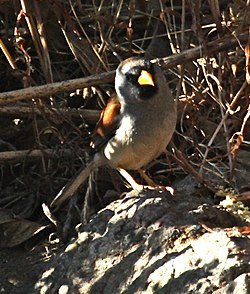| Great Inca finch | |
|---|---|
 | |
| Scientific classification | |
| Kingdom: | Animalia |
| Phylum: | Chordata |
| Class: | Aves |
| Order: | Passeriformes |
| Family: | Thraupidae |
| Genus: | Incaspiza |
| Species: | I. pulchra |
| Binomial name | |
| Incaspiza pulchra (Sclater, PL, 1886) | |
 | |
| Synonyms | |
Haemophila pulchra (protonym) | |
The great Inca finch (Incaspiza pulchra) is a species of passerine bird in the tanager family Thraupidae. It was traditionally placed in the family Emberizidae. It is endemic to Peru.
Its natural habitat is subtropical or tropical high-altitude shrubland.

